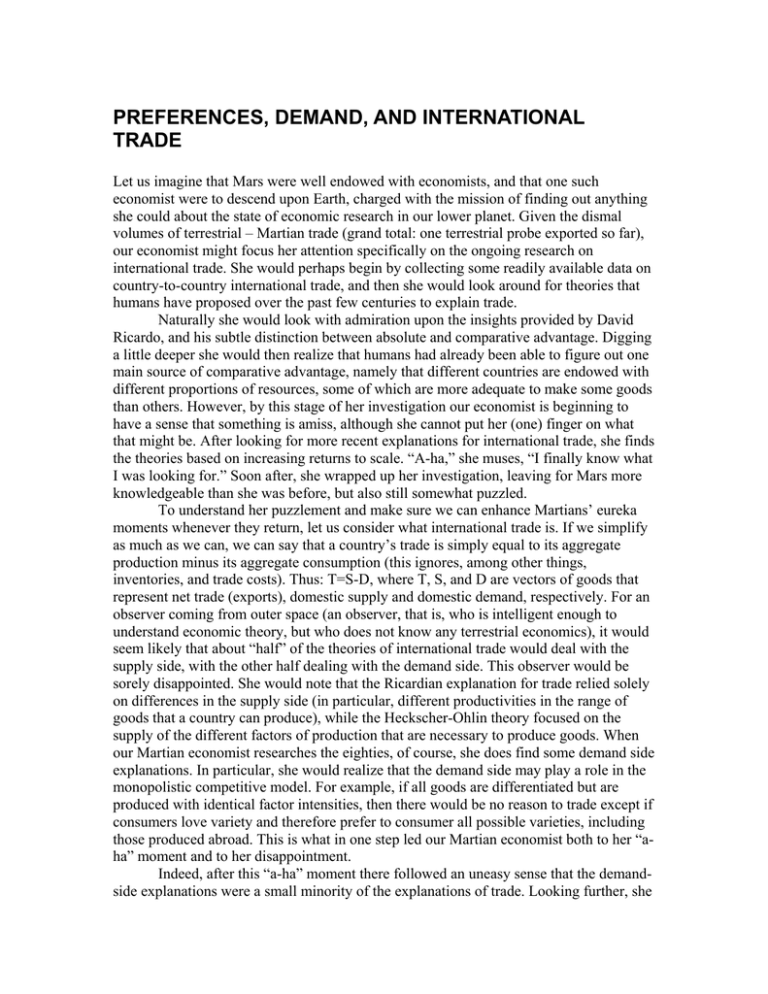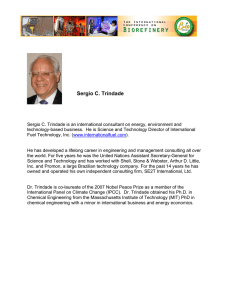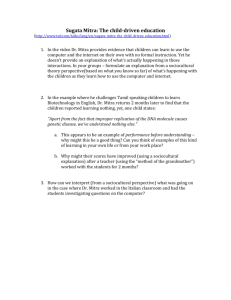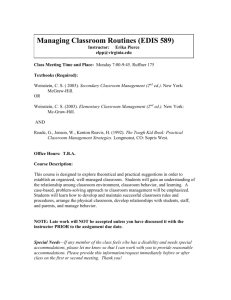PREFERENCES, DEMAND, AND INTERNATIONAL TRADE
advertisement

PREFERENCES, DEMAND, AND INTERNATIONAL TRADE Let us imagine that Mars were well endowed with economists, and that one such economist were to descend upon Earth, charged with the mission of finding out anything she could about the state of economic research in our lower planet. Given the dismal volumes of terrestrial – Martian trade (grand total: one terrestrial probe exported so far), our economist might focus her attention specifically on the ongoing research on international trade. She would perhaps begin by collecting some readily available data on country-to-country international trade, and then she would look around for theories that humans have proposed over the past few centuries to explain trade. Naturally she would look with admiration upon the insights provided by David Ricardo, and his subtle distinction between absolute and comparative advantage. Digging a little deeper she would then realize that humans had already been able to figure out one main source of comparative advantage, namely that different countries are endowed with different proportions of resources, some of which are more adequate to make some goods than others. However, by this stage of her investigation our economist is beginning to have a sense that something is amiss, although she cannot put her (one) finger on what that might be. After looking for more recent explanations for international trade, she finds the theories based on increasing returns to scale. “A-ha,” she muses, “I finally know what I was looking for.” Soon after, she wrapped up her investigation, leaving for Mars more knowledgeable than she was before, but also still somewhat puzzled. To understand her puzzlement and make sure we can enhance Martians’ eureka moments whenever they return, let us consider what international trade is. If we simplify as much as we can, we can say that a country’s trade is simply equal to its aggregate production minus its aggregate consumption (this ignores, among other things, inventories, and trade costs). Thus: T=S-D, where T, S, and D are vectors of goods that represent net trade (exports), domestic supply and domestic demand, respectively. For an observer coming from outer space (an observer, that is, who is intelligent enough to understand economic theory, but who does not know any terrestrial economics), it would seem likely that about “half” of the theories of international trade would deal with the supply side, with the other half dealing with the demand side. This observer would be sorely disappointed. She would note that the Ricardian explanation for trade relied solely on differences in the supply side (in particular, different productivities in the range of goods that a country can produce), while the Heckscher-Ohlin theory focused on the supply of the different factors of production that are necessary to produce goods. When our Martian economist researches the eighties, of course, she does find some demand side explanations. In particular, she would realize that the demand side may play a role in the monopolistic competitive model. For example, if all goods are differentiated but are produced with identical factor intensities, then there would be no reason to trade except if consumers love variety and therefore prefer to consumer all possible varieties, including those produced abroad. This is what in one step led our Martian economist both to her “aha” moment and to her disappointment. Indeed, after this “a-ha” moment there followed an uneasy sense that the demandside explanations were a small minority of the explanations of trade. Looking further, she would have found that the “eclectic” explanations by Markusen (1986) included nonhomothetic preferences as a cause for trade. But moving to more recent research, it would have seemed that the demand side disappeared again. For example, in their account of global factor trade, Davis and Weinstein (2001) only briefly consider it. Furthermore, in their review article (Davis and Weinstein 2003), they state that “another area that cries out for more research is the demand side of the model.” It is to address this kind of puzzlement that some more recent research has arisen. In the first published piece whose focus is almost entirely on the demand side, Mitra and Trindade (2005) abstract from supply considerations by assuming that all countries have identical constant-returns-to-scale technologies and identical supply of factors and there are only two homogeneous goods. That means that in the classical theory of trade there would be no trade, since the “Y” in the formula for trade would be identical across countries. But in Mitra and Trindade's model there will be trade, caused by differences in the “D.” These differences arise because the authors assume that preferences are nonhomothetic, implying that the rich and the poor in one country consume different combinations of goods. Assume now that countries are only different in the income inequality within each country. Suppose that we increase the inequality level in a country by taking one dollar from a poor person and giving it to a rich person. Because preferences do not “scale up,” when these two operations are translated into consumption changes, they do not just cancel. In particular the poor person will decrease his consumption of basic necessities such as food, while the rich person will increase his consumption of luxury goods, such as tourism. Therefore, as the country is growing in inequality, the larger its aggregate consumption of “luxury” goods will be, and the smaller its consumption of “necessity” goods. Going back to our model world of two countries, this means that the unequal country consumes more luxuries and fewer necessities. But since we assumed that their supplies are the same, the two countries will trade, and in particular the unequal country will export necessities and import luxuries. The driving force of their trade (in the formula where T=S-D) is then placed squarely on the “D.” This theory is confirmed empirically by Dalgin, Trindade and Mitra (2007). Even more recent research takes up the challenge by Davis and Weinstein (2003), and attempt, as Davis and Weinstein (2001) have done, to account for the global factor content of trade. See Reimer and Hertel (2007) for an example. Kim and Trindade (2007) deduce how the factor content of trade is modified when the demand side is changed from simple homothetic and identical tastes to more complex situations, and find new testing equations that account for trade. This research is very preliminary but there are some indications of the importance of demand on trade. We hope that this line of research will finally be able to “put demand back on trade,” as expected by our neutral Martian observer. Dalgin, Muhammed, Vitor Trindade, and Devashish Mitra (2007) “Inequality, Nonhomothetic Preferences and Trade: a Gravity Approach,” Southern Economic Journal, forthcoming. Davis, Donald R. and David E. Weinstein. 2001. “An Account of Global Factor Trade.” American Economic Review, 91 (5), 1423-1453. Davis, Donald R. and David E. Weinstein. 2003. “The Factor Content of Trade.” In Kwan Choi and James Harrigan (eds.), Handbook of International Trade. Basil Blackwell. Kim, Yeonjoon and Vitor Trindade. 2007. “Demand and Supply Effects in the Factor Content of Trade,” University of Missouri manuscript. Markusen, James R. 1986. “Explaining the Volume of Trade: an Eclectic Approach,” American Economic Review 76, 1002-11. Mitra, Devashish and Vitor Trindade. 2005. “Inequality and Trade,” Canadian Journal of Economics, 38 (4), 1253-1271. Reimer, Jeffrey J. and Thomas W. Hertel. 2007. “Non-homothetic Preferences and International Trade,” Oregon State University manuscript.








